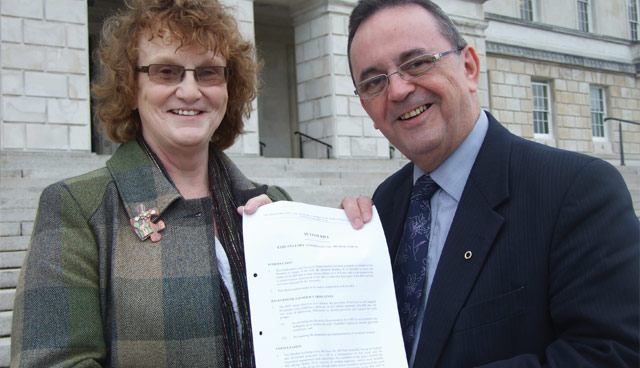Moving the Autism Act forward

Renewed calls for the full implementation of Northern Ireland’s Autism Act, passed in 2011, have focussed a spotlight on the lack of provision in Northern Ireland for those with autism spectrum disorder (ASD). agendaNi examines the Act, its delay and how the Scottish Strategy for Autism, also published in 2011, has shown what progress Northern Ireland could have made by now.
The Scottish Strategy for Autism carried with it 26 aims and recommendations overall, including the production of an annual report, cross-agency work between the NHS, the Convention of Scottish Local Authorities (COSLA) and criminal justice organisations to implement various autism guidelines and the application of the work of Martin Knapp, the London School of Economics professor who has analysed the economic cost of autism in the UK, to a strictly Scottish context. The strategy also called for an assessment of the national waiting lists, an issue that is evident in Northern Ireland, not just in autistic diagnostic services, but across the health system as a whole.
The latest Northern Ireland Waiting Time Statistics report, published in February 2019, found that 51.5 per cent of patients waiting for a diagnosis had been waiting more than nine weeks on 31 December 2018, more than double the target of 25 per cent or under. There were 124,746 patients awaiting diagnostic services in Northern Ireland by 2018’s end, a 1.9 per cent increase on the previous quarter and a 10.7 per cent increase on the same quarter in 2017.
Against this backdrop, stories of a young boy waiting over six months for an autism diagnosis have appeared in the media, along with reports of autism diagnoses in Northern Ireland’s children rising by more than 100 per cent and thousands waiting to be assessed. The current situation is a long way from the optimism felt by those with ASD and their families and carers when the Autism Act was passed in 2011.
A series of action plans arising from the Act were drawn up in 2013, with three action plans due to be completed by 2020, but the first plan has yet to be completed. While most hold-ups in the governance of Northern Ireland can be blamed on the absence of the Assembly and Executive, the failure to act on the Autism Act stretches back a full four years before the Stormont Government collapsed.
Like the Autism Act, the Scottish Strategy for Autism was introduced in 2011. It is a 10-year national strategy for autism, intended to cover the entire spectrum of those with ASD and their entire lifespans. The strategy called for the investment of £13.4 million over its first four years and recognised that those with ASD “need to be supported by a wide rang of services such as social care, education, housing, employment and other community-based services”.
The strategy set out goals in three phases: two years, five years and 10 years. Its two year goals include the guarantee that all of those with ASD would have: access to mainstream services where they are appropriate to meet individual needs; access to services that understand and can meet the specific needs of people related to their type of autism; removal of short-term barriers such as unaddressed diagnoses and delayed intervention; access to post-diagnostic support for the individuals and their families; and the implementation of then-existing commissioning guidelines.
Within five years, the strategy planned to have implemented: access to integrated service provision across lifespan to address the multi-dimensional aspects of autism; access to appropriate transition planning; a consistent adoption of good practice guidance in key areas such as education, health and social care in local authority areas; and capacity and awareness building in mainstream services to ensure people are met with recognition and understanding.
Finally, the strategy aims for 2021, 10 years from its publication were: the establishment of meaningful partnerships between central and local governments and the independent sector; creative and collaborative use of service budgets to meet individual needs; access to appropriate assessment of needs throughout life; and access to consistent levels of support across the lifespan of those with ASD.
|
Ten indicators for Autism Spectrum Disorder (ASD) best practice: • A localised autism strategy • Access to autism training and development for professionals • The establishment of a process for ensuring a means of easy access to information • An ASD training plan • A process to improve both data collecting and the quality of data collected regarding autism • A multi-agency care pathway for assessment, diagnosis and intervention to improve support • A framework and process for seeking stakeholder feedback • Autism services that demonstrate multi-agency focus and coordination • Clear multi-agency procedures and plans • A self-evaluation framework Source: Scottish Strategy for Autism |
The Scottish Government published a report on the progress made in the strategy’s first two years in 2014. Entitled the Foundation Phase, it detailed significant progress made during the two years, including the development of a Menu of Interventions – “a guide to help people on the autism spectrum and their families and carers identify available advice and support”. A mapping exercise was conducted for local autism services to improve their coordination. There was also a one-off investment of £35,000 for each local authority in Scotland to develop local autism strategies and action plans. £4.5 million was pledged to Autism Development Funds, aimed at encouraging local and national organisations to develop their delivery of local autism services.
The strategy was then refreshed by the Scottish Government and COSLA in order to reframe it as a more outcomes-based plan for the period of 2015-2017 in line with the outcomes-based approach of Scotland’s National Planning Framework. The desired outcomes for the period were stated as “healthier life, choice and control, independence and active citizenship” for those with ASD.
Achievements outlined by the Scottish Government since the shift in approach in 2015 include: the investment of over £2 million in more than 40 autism charities and projects, directly effecting roughly 6,000 autistic people, their families and carers; a pilot of six One Stop Shops to provide early intervention post-diagnostic support; the development of Scottish Autism’s Right Click programme for women and girls; and the development of the Autism Training Framework – Optimising Outcomes – for those working in health and social care.
With plans that included changing the Disability Discrimination Act (DDA) definition of disability so that people with autism would no longer be measured solely by intellectual or physical ability, improving access to services and benefits on the basis of the level of social and communication impairment and function, where previously DLA had been disallowed, cross-agency coordination and the improvement of data collection, Northern Ireland could have been on its way to the impressive levels of ASD services now seen in Scotland. The reality, however, is another plan made with the best of intentions and all-party backing left to flounder in the machinations of government.





